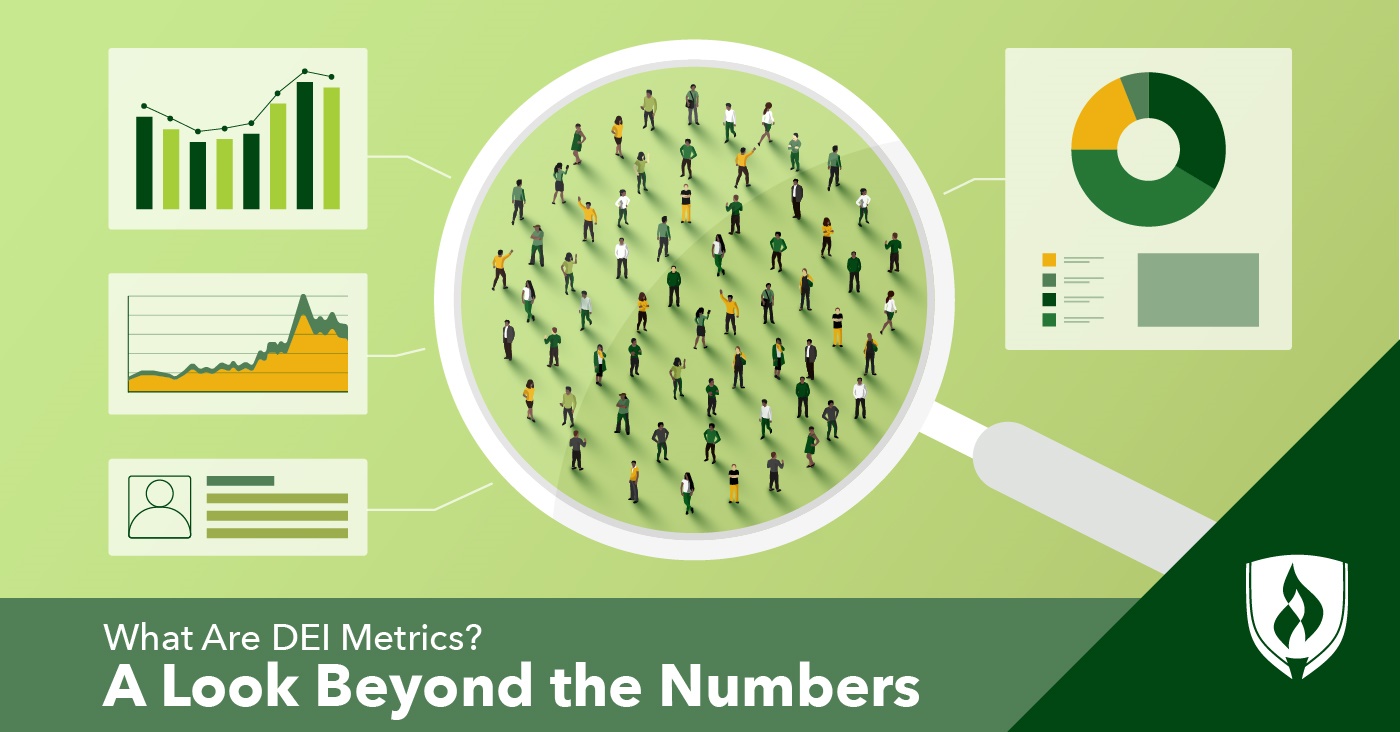
Diversity is a hot topic in the business world—and for good reason. Whether we are talking about nature, our biology and diet, our social relationships or the workplace, studies indicate the more diverse various systems are, the stronger they are for it. Today, businesses around the world seek ways to strengthen their workforce by casting a wider net to make sure different voices are heard and elevated.
One of the key avenues for making sure this happens is through the implementation and monitoring of diversity, equity and inclusion (DEI) metrics and taking further action based on the associated findings.
But what exactly are DEI metrics? How are they measured? More importantly—are the DEI metrics that organizations track actually influencing change?
These are questions worth digging a little more into, as the answers demand a bit of our attention. Whether you came here for a definition of a term that you heard or you are someone passionate about creating more diverse, equitable and inclusive workplaces, keep reading. The answers below and words from experts will help you garner a fuller understanding of the term and how these metrics may evolve in the future to increase their effectiveness.
What are DEI metrics?
Let’s start with the basics. As we established above, DEI is an acronym that stands for diversity, equity and inclusion. DEI metrics are practical ways for companies to measure and assess their own ability to form a workplace that is finding, highlighting and advancing diverse voices.
Here are some key ways companies measure and assess their progress in DEI:
Representation and hiring
This is often the starting point when a business first starts keeping track of DEI metrics. The business as a whole is assessed by keeping track of things like an individual’s ethnicity or gender. Then the process is broken down in various departments with emphasis on the leadership of the company.
Retention and advancement
It is one thing to hire individuals for a job, and it is another thing to evaluate how many are thriving in the workplace. Are there stark differences in employee tenure? Are certain groups more likely to advance? While what’s at the heart of these differences may require a nuanced investigation, metrics focused on retention and advancement can certainly highlight trends worth digging into.
“For my company, the biggest indicator of success concerning DEI metrics is how long the employees stay with the company,” says business consultant Kamyar Shah. “Increased retention and engagement tell you a lot about your DEI policies. If your employees from diverse backgrounds tend to stick around, that means they’re satisfied and see growth opportunities within the firm.”
Job satisfaction and engagement
Part of the metrics may include individual questionnaires that ask how different people are fitting into a company. Are your employees happy? Are their needs being met? Are certain individuals thriving under a company’s culture while others aren’t? Questions about employee satisfaction and engagement can help paint a more holistic picture of what is going on behind the scenes.
Accessibility
Does everyone in the organization have easy access to their workspace, the bathrooms or cafeteria? Are internal sites and resources ADA compliant? Do parents have the ability to deal with childcare issues (maternity/paternity leave or breastfeeding)? Who faces barriers engaging in the daily life of your workplace? Assessing these focus areas is important not only for ensuring the organization is meeting legally mandated requirements but also for identifying ways to proactively make your workplace more accommodating to all.
These specific metrics are just the start in terms of the many necessary ways a company can assess its culture. Of course, it’s important to keep in mind that establishing DEI metrics by collecting quantitative and qualitative data is only a starting point for organizations. From here, they must thoughtfully determine how to address any potential shortfalls identified.
“If a company has the goal of being people-first and providing equal opportunities, but doesn’t have an accurate view of a people story, it will be incredibly hard to meet that goal,” says Laura Close, co-founder of Included.
Why are DEI metrics important?
DEI metrics can inform how businesses approach DEI initiatives. We’re all susceptible to both clear and hard-to-perceive biases, so metrics paired with thoughtful analysis can help shine a light on areas for improvement that may be getting overlooked.
The benefits of these efforts aren’t just about doing right by society at large. Fundamentally, studies have shown businesses that are more diverse, equitable and inclusive are better off for it. Let’s take a closer look at some of the potential benefits of an inclusive workplace.
Better overall performance
Organizations with inclusive cultures are twice as likely to meet or exceed financial targets, three times as likely to be high performing, six times more likely to be innovative and eight times more likely to achieve better business outcomes, according to a 2018 Deloitte® report on diversity and inclusion.1 When you have different voices at a table, companies thrive.
Increased collaboration and employee buy-in
Inclusive leaders can have a positive impact on their teams’ work. The Deloitte report found that inclusive leaders lead to a 70 percent increase in “experiences of fairness, respect, value and belonging.” This leads to a 17 percent increase in team performance, a 20 percent increase in decision-making quality and a 29 percent increase in team collaboration.1
If a team feels empowered to share their distinct points of view, assumptions can be challenged, new ideas can come to the forefront and employees may become more invested in their work.
Increased innovation
And lastly, diversity of thinking stimulates innovation. The Deloitte report found that workplaces that have diversity in people and thinking help one another use their different perspectives to increase innovation and reduce risk.1 This intrinsically makes sense—the more points of view you can have focusing on a problem, the better an organization is able to identify where things can go wrong and potential courses of action.
How can DEI metrics influence change?
The observation and gathering of DEI data is not a comprehensive strategy for bringing about change. It is merely a first step for organizations to figure out where they stand. Once gathered, this information can be used as a basis point for improvement initiatives and as a benchmark to gauge progress. Additionally, publicly shared DEI findings, like what Google® and 23andMe® have done in the past, can provide a limited avenue for the public at large to hold organizations to account.
Moving from simple measurement to making meaningful change is a big step that requires substantial and lasting buy-in from employees, human resources professionals and organizational leadership. While there’s a host of potential initiatives that can help improve “the numbers” for DEI metrics, the reality is that this is a process that will take time, and you can’t just move on after what’s deemed a “success.”
“I often caution the use of the word ‘success’ in conversations around DEI,” says Kim Crowder, DEI consultant. “First, because we are combating hundreds of years of systemic oppression, I prefer the term progress as a baseline. We look at the impact of strategy, whether that includes changes in policy, workplace culture, management styles, accountability methods, and updates in processes, over time.”
What does the future of DEI look like?
“Hopefully, we will see more accountability at the governmental level in influencing organizations and holding them to standards,” Crowder says. She explains, for example, that efforts in New York City to set salary minimums and maximums need to also include DEI metrics to set boundaries for protected classes. “The challenge is always how to make sure that these types of efforts do not benefit certain groups and not others. This is why DEI is such nuanced work that requires skill, lived experiences and data-driven approaches.”
DEI metrics may come to play a role in helping job applicants discern where they should apply, according to Shah. “We’ll see employers highlighting DEI metrics in their job advertisements,” says Shah. “With more people becoming aware of the importance of diversity and inclusion in the workplace, companies will begin using these metrics as a means to attract top talent.”
DEI metrics may even play a further role for prospective investors. “More investors are interested in seeing companies take action on climate change, and I think we’ll see a similar focus on diversity and inclusion in the years to come,” says Mark Koning, chief human resource officer at Discover Business.
From potentially being used to set government policy to helping companies stand out in terms of hiring and investment opportunities, DEI metrics and the initiatives tied to them seem poised to play a huge role in our future.
Driving change as an HR professional
Meaningful diversity, equity and inclusion efforts undoubtedly require commitment from all levels of the organization—from the board on down. That being said, professionals working in human resources are in a position to play an outsized role in building a culture that values the perspectives of all employees. If you’d like to learn more about the people dedicated to this effort, check out our article “The HR Professional’s Guide to Diversity and Inclusion Jobs.”
1Juliet Bourke, “The diversity and inclusion revolution: Eight powerful truths,” Deloitte Insights, The Deloitte Review, issue 22 last modified January 22, 2018 [accessed April 2022] https://www2.deloitte.com/us/en/insights/deloitte-review/issue-22/diversity-and-inclusion-at-work-eight-powerful-truths.html.
Deloitte is a registered trademark Deloitte Touche Tohmatsu.
Google is a registered trademark of Google, LLC.
23andMe is a registered trademark of 23andMe, Inc.




